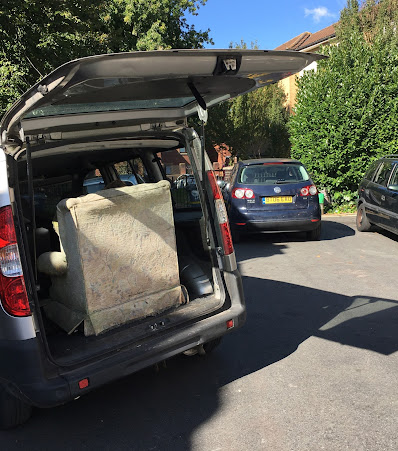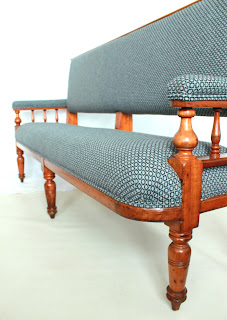Orange Peel Fungus Chair - collaboration with artist Julie Ann Sheridan.
This was a Guerrilla Reupholstery project made from the bones of this chair that we took from the streets of Bristol
and turned it into this:
Here's the story behind it.
I was inspired by the Instagram account of Bristol-based upholsterer Sadie Campbell who photographs discarded furniture on the streets of Bristol (check out
@sadiedidi). There seems to be so much of it that I thought I have to do something about it. So I asked her to locate an armchair that I could pick up when I was driving back to Wales via Bristol. She very kindly found the one above in Easton. Here it is in the back of the van.
I took it back to the workshop and this is what we had to work with.
Clearly it had been out in the street for months but I set myself the task of turning it into an armchair that was unconventional and striking to look at but also comfortable and durable as furniture has to be. I added the restriction of using only the component parts of this armchair along with waste products from my reupholstery business like foam and wadding offcuts and also scrap wood from the workshop woodpile. So apart from the fabric everything would be made from things that would otherwise go to landfill.
I wanted to make the point that to an upholsterer, flytipped furniture is not necessarily the junk that everyone else thinks it is. This is because unlike almost everyone else, the upholsterer has the tools and facilities to completely transform a piece of furniture, that is, not only to reupholster it but to completely redesign it.
So I started to strip the chair to see what I had to work with. Well I say 'I' but as always I asked my excellent assistant Jacob to strip it for me. And frankly I'm glad I did because I don't think I could have stomached it. (It's important to stress that he did get paid for this). Here's what we found.
Manky rotten canvas and rusty serpentine springs.
A rotten frame infested with slugs.
And the biggest woodlouse in the history of the universe.
So when Jacob had dealt with the horror, got rid of the insects, rotten wood and canvas, disinfected everything and been through counselling, this is what we had left to work with.
And on closer inspection the base just seemed too far gone so in the end we were only left with this much wood.
And this much foam and stuffing.
How on earth could I make a chair out of this? To be honest it felt like the chair we picked was just too far gone. Most furniture isn't left on the street as long as this so would be in much better condition but I couldn't let the work we'd already done come to nothing and if I could make something good out of this crap it would further prove my point. But I realised I'd need some help with the design process - enter artist
Julie Ann Sheridan, who as luck would have it, also happens to be my wife.
Julie is an abstract painter who often works with lichen, fungus and other organic forms, making paintings like this:
So I asked her to come up with some loose designs for a chair based on irregular organic forms that might serve as inspiration. Here's what she came up with
From this we settled on the Orange Peel Fungus.
Ok then.
So I started fixing up the frame by turning it upside down so the wings were now the arms and the arms the back supports. The arm scrolls came in handy for back rail supports and I started adding bits of hardwood from the waste wood pile. This seemed to give something of the shape we were after.
Next I made a set of legs, again from scrap wood.
I attached the legs, webbed the back with jute webbing and finished the seat with serpentine springs salvaged from another chair (the ones in the street chair were too rusty). Then I angled the top rail for an irregular shape.
Then I started with the foam. I used everything from the street chair and filled in any gaps with offcut strips from the waste foam pile in the workshop.
This is the last photo I have of the foam stage but in fact I added quite a bit more round the sides and back to give a more rounded shape.
So now I just had to cover it.
As the chair had to be made only from re-used or sustainable products we chose wool. We went for my favourite tweed from Bute Fabrics in this fabulous orange colour.
And finally with a bit more jiggery-pokery, a few buttons, a fair bit of hand stitching and some irregular pleating here's the final product.
I hope you think it was worth the effort. And even if you don't I hope you understand the point I'm trying to make:
UPHOLSTERERS CAN TRANSFORM FLYTIPPED FURNITURE AND SAVE IT FROM LANDFILL.
So I'm starting a Guerrilla Reupholstery service where I hope to work with other designers, architects, artists or directly with customers who want to make bespoke sustainable furniture from flytipped junk. It doesn't have to be unusual like this chair, we can make ordinary chairs too, in fact pretty much anything you want.
Get in touch.

.jpeg)
.jpeg)
.jpeg)
.jpeg)
.jpeg)











.jpeg)


















































